What is the name of the cabbage that looks like turnip
One of the botanical varieties of cabbage has an external resemblance to turnips. The origin of the plant is associated with the Eastern Mediterranean. The unusual in appearance vegetable is cultivated in Europe, Asia and North America. Thanks to simple agricultural techniques, it is grown even in the northern regions of Russia.
The content of the article
What is the name of the cabbage that looks like turnip
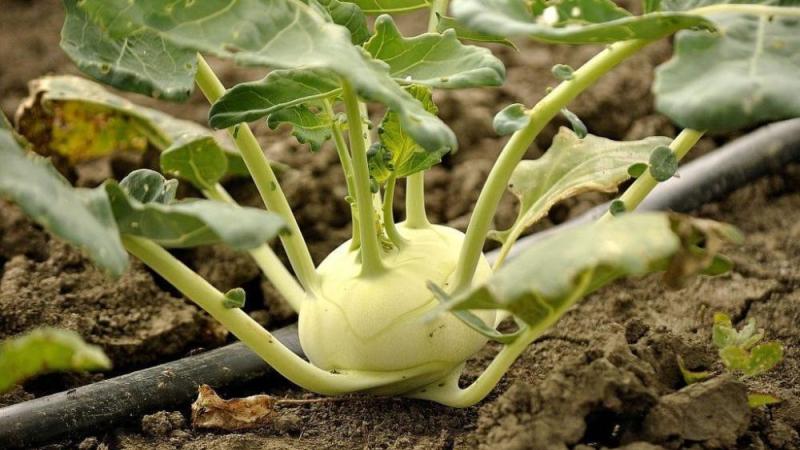
Kohlrabi - this is the name of the cabbage, which has a spherical stem. The word is derived from the German Kohl ("cabbage") and Rabi ("turnip"). The Italian name cavolo rapa has the same meaning. Kohlrabi is also called turnip cabbage (cabbage turnip).
What does kohlrabi cabbage look like?
The culture refers to biennial plants. Its main feature is the absence of a head of cabbage from densely packed leaves. In the first year of growth, a turnip-shaped stem crop is formed (in the lower part of the stem), on which petiole leaves grow.
Other cultural features:
- The average diameter of the stem is from 10 to 15 cm, weight - from 150 to 500 g. Late varieties are large in size, sometimes weighing up to 3 kg.
- The pulp is snow-white in any variety (regardless of external features), with a dense structure.
- Large, elongated leaves with serrated edges are ovoid or triangular in shape.
- The color of the peel is light or red-purple, the leaves are green with a different shade depending on the variety.
Flowering and seed formation in most species occurs in the second year.... On the shoots, white or yellow corollas up to 1.5 cm wide grow.At the same time, lignification of the tissues occurs - the overripe stalk becomes unsuitable for food.
Kohlrabi flavor
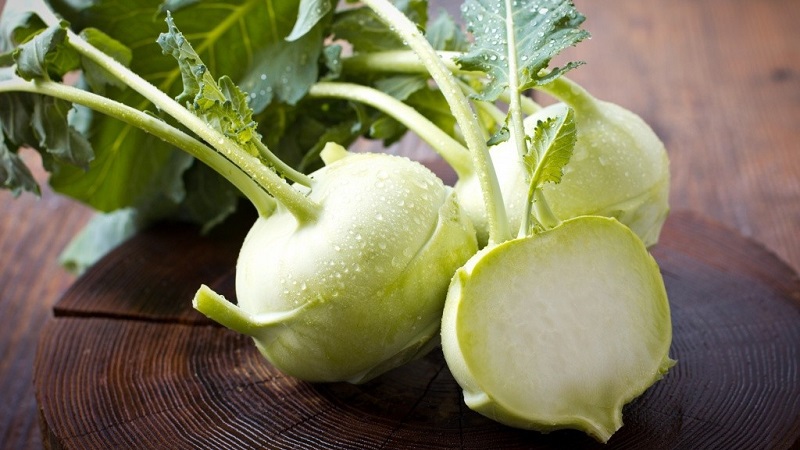
The culinary uses the plant stem and leaves. Turnip cabbage has a delicate pulp. The youngest specimens have the best taste.
Attention! It is recommended to eat stems with a diameter of 6-10 cm. The overgrown ones become tough and fibrous. Early ripening varieties of white have the most delicate pulp.
Kohlrabi fruits contain a rich vitamin and mineral complex, enzymes and fiber. The taste of the vegetable is sweetish due to the sucrose content. It resembles a cabbage stump, but is more juicy and has no bitterness.
Taste characteristics change during cooking:
- When grated, kohlrabi takes on a nutty flavor with notes of celery. After dressing with vegetable oil, the pulp resembles a radish, but more tender.
- Boiled kohlrabi, in terms of taste, becomes similar to both turnips and white cabbage. At the same time, the pulp retains sweetness and juiciness.
Before eating, the stem crop is peeled and washed with cold water. Kohlrabi can be stewed, fried, boiled, consumed raw. The vegetable is used for baking in breadcrumbs or batter, stems canning, dried.
Turnip cabbage leaves are also edible, they taste like spinach.
Popular varieties of kohlrabi cabbage with photos and descriptions
Kohlrabi is an unpretentious plant that is highly resistant to diseases and pests. Cabbage gets along well with other vegetable crops, bears fruit in open and protected ground. Thanks to these features, it is grown throughout Russia. The short ripening period allows harvesting 2-2.5 months after landing.
Important! In comparison with other subspecies of cabbage, the culture is less demanding on the composition of the soil, but it needs timely watering.On dry soil, the stems have an unattractive appearance, grow small and coarse.
There are the most common varieties, they differ in ripening speed, storage characteristics and appearance.
Delicacy red
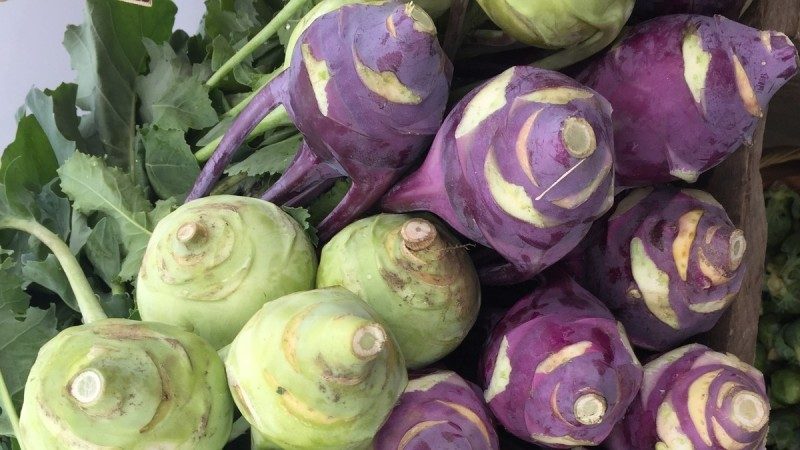
This variety is classified as ultra-ripening. The ripening period is 65 to 75 days. The plant is frost-resistant.
External features:
- stem fruit is red-purple in color;
- diameter - from 8 to 10 cm;
- weight - from 1.5 to 2 kg.
With monthly sowing of seeds, 3-4 crops can be harvested. The advantages of the variety are resistance to woodiness, cracking. The stem does not outgrow, does not release flower shoots. Does not lose taste during long-term storage (until spring) and transportation.
The variety is appreciated for its taste. Differs in a rich vitamin complex, high sugar content.
Giant
The plant belongs to the late-ripening Czech varieties. The main difference is a large semi-vertical rosette of leaves. The period from first germination to harvest is from 89 to 100 days.
Appearance:
- the stemfruit is whitish with a greenish tinge, has a concave top;
- weight reaches 2.5-3 kg;
- diameter - from 15 to 20 cm;
- wide-oval gray-green leaf plate (medium waxy bloom, whitish-green veins).
The stems are juicy. The variety is resistant to drought, the vegetable is suitable for long-term storage.

Vienna
The most common varieties include kohlrabi Vienna. It comes in two varieties - white and blue.
Blue
The mid-early variety has a ripening period of 72 to 87 days and is frost-resistant. External description:
- bluish-lilac stem fruit (round-flat shape);
- average weight - 160 g;
- diameter - about 8 cm.
The peculiarity of the variety is that the stem grower is located high above the ground, practically does not outgrow. Suitable for storage.
White
This is an early ripening variety, the period of formation of stems before harvest is from 65 to 78 days. Up to four crops can be harvested per season.
Cabbage has a juicy pulp and high sugar content. External features:
- half-raised socket;
- light green stem fruit;
- diameter - from 7 to 9 cm;
- weight - about 100 g.
The variety is drought-resistant, but prone to overgrowth, unsuitable for long-term storage.
It is interesting:
Simple and delicious recipes for making sauerkraut with vinegar.
A selection of the best varieties of cabbage for pickling and storage for the winter.
Violet
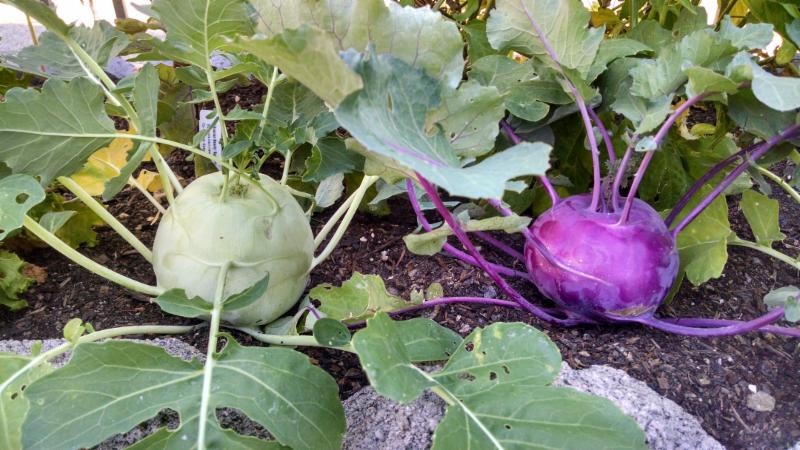
The variety belongs to the late-ripening varieties of Czech selection, one of the most frost-resistant. From first germination to harvest, it takes 70 to 78 days.
External features:
- the stemfruit is dark purple (with a bluish tint);
- shape - round-flat;
- weight - from 1.5 to 2 kg;
- semi-vertical leaf rosette (50-70 cm in diameter);
- blue-green leaves of a flat oval shape (light purple streaks).
It is characterized by average keeping quality during winter storage.
Reference! Violetta is one of the varieties used to decorate garden landscapes.
Kossak
The late-ripening variety is distinguished by its high taste. The leaf rosette is located semi-vertically, it is formed by large dark green leaves. The wax coating is medium.
Features:
- stem fruit yellow-green;
- weight - from 450 to 600 g;
- shape - elliptical with a flat top.
This variety is especially common in cold climates.
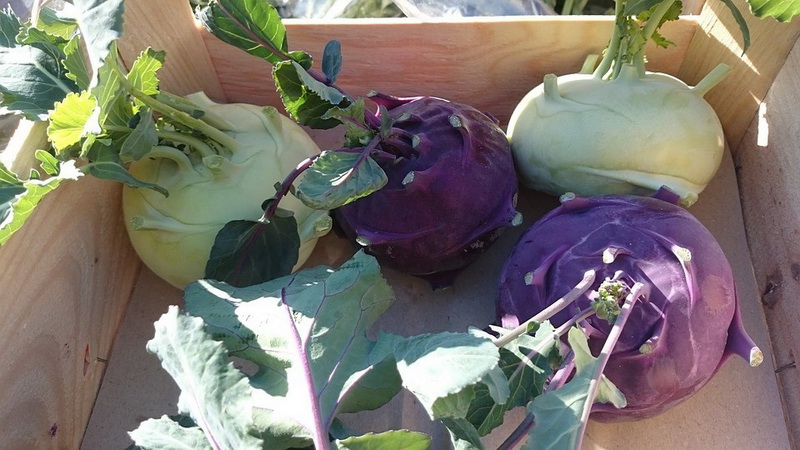
Conclusion
Kohlrabi is a healthy and tasty vegetable with a rich chemical composition, which is easy to grow in your own summer cottage. When choosing a variety, it is important to take into account the climate of the region, keeping quality when intending to store the crop in winter. Some varieties of kohlrabi can become not only a useful product, but also a garden decoration.